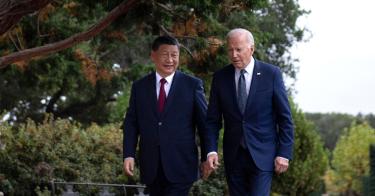We now have new revelations of corruption in the Chinese People’s Liberation Army resulting in, among other things, “missiles filled with water instead of fuel” and missile silos “with lids that don’t function.” According to U.S. officials, this latest bout of corruption “led to an erosion of confidence in the [PLA’s] overall capabilities” and made President Xi Jinping “less likely to contemplate major military action.” Xi responded by purging at least a dozen PLA leaders implicated in the scandal.
This report is a reminder that the PLA faces significant challenges—and that the United States should use every opportunity to exacerbate those difficulties. But the United States should not use this episode as an excuse to grow complacent.
The preponderance of evidence shows China’s military is still modernizing rapidly, regardless of corruption. Moreover, even if Xi’s confidence in the PLA took a hit last year, he is clearly committed to correcting deficiencies as quickly as possible, and there is a good chance he will succeed.
>>> EVENT: Launch of The Heritage Foundation’s 2024 China Transparency Report
Mao Zedong said “power grows out of the barrel of a gun,” and Xi Jinping clearly agrees. According to CIA Director William Burns, Xi has directed the PLA to be ready to seize Taiwan by 2027, and he has invested China’s resources accordingly. Not only did China prioritize defense spending over other investments during the COVID-19 pandemic, but it also reportedly spends far more on defense than previously understood—perhaps as much as $700 billion per year. At the same time, Xi is personally invested in keeping PLA modernization on track and has significantly improved oversight of the PLA to that end.
The results are clear: The PLA is modernizing rapidly across warfighting domains. China’s air forces, for instance, will enjoy a significant numerical advantage near Taiwan and are increasingly capable, with improving threat sensors and post-processing capabilities, airborne early warning and control aircraft, fifth-generation fighters, and long-range air-to-air missiles.
Meanwhile, China’s naval force is the world’s largest, with highly capable warships and large paramilitary and civilian fleets at its disposal. It is also still growing—quickly—while the U.S. Navy shrinks by the year. Trends may also favor China in space, cyberspace and electronic warfare, and Chinese military exercises are increasingly sophisticated and realistic.
The PLA Rocket Force—the focus of the latest corruption scandal—is making strides, too. China already boasts a massive arsenal of ballistic and cruise missiles, while China’s nuclear forces are on track to nearly quadruple in size in the next decade. China is also at the forefront of missile technology, especially in hypersonics. In 2021, for instance, China shocked the world by testing a fractional orbital bombardment system armed with a hypersonic glide vehicle. According to the U.S. Defense Department, China is probably also developing an additional strategic hypersonic glide vehicle, more survivable intercontinental-range ballistic missiles and a conventional intercontinental missile.
>>> What Taiwan’s Election Tells Us About China and 2024
These are impressive accomplishments by any objective measure, and they occurred despite the PLA’s ongoing problems with corruption. Consequently, shocking as these recent revelations are, American policymakers should not bet on corruption to hamstring PLA modernization, nor should they expect corruption or the effects of it to stay Xi’s hand. If they want to avoid war, they must instead take China seriously and prioritize investing in America’s ability to deter this powerful rival.
Unfortunately, the Biden administration has made clear it wants to focus less on China amid other geopolitical crises and the upcoming presidential election. To that end, the administration has routinely downplayed Chinese threats, from the Chinese spy balloon to the declassification of intelligence about the origin of COVID-19.
Indeed, the timing and content of the recent revelations suggest they are part of a similar campaign to ease pressure on the administration to confront China. But Beijing is not waiting.
The administration may not want to confront China, but Xi Jinping is clearly preparing for war with the United States. So long as the administration is determined to avoid doing what is required to deter China, then risk of conflict will only grow.
This piece originally appeared in Defense News



